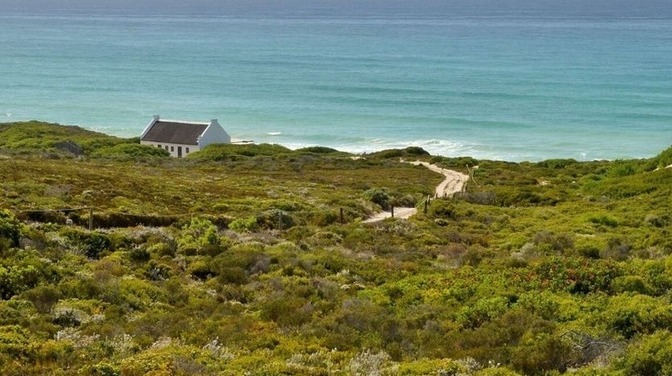Select a category
History of Napier
Tucked away at the foot of the Soetmuisberg lies a village whose history can only be described as a quirky mixture of country living and controversy. Woven intricately into the history of the infamous Cape Agulhas, the history of Napier is one you can definitely sink your teeth into.
Established in 1836, Napier didn't have the easiest of starts. The establishment of the village came about as a result of a dispute between two neighbours which in the end gave birth to the two neighbouring towns of Bredasdorp and Napier.
.jpg?width=680)
The dispute came about when Michiel van Breda and Pieter Voltelyn van der Byl couldn’t decide where to build the community church. Van Breda was of the opinion that the church should be built on his farm Langefontein, while Van der Byl believed the church should be built on his property Klipdrift and neither would budge. In the end, the two gentlemen each built a church on their own respective properties and thus the two towns came about. Two years later, the town of Napier was officially named after the then Governor of Cape Town, Sir George Thomas Napier.
With the site of the community church and the name of the town finally established, next on the agenda was the main road. For many years, High Street (Hoog Straat) was the main road of Napier. The plots of High Street used to run all the way down to the area now known as Tamatieskraal, having the houses on High Street and the rest of the plot holding small patches of gardens and/or horses, cows and chickens. The higher main road did however bring with it some hardship for folks travelling through the town with ox wagons and carts to get up the hill to head through the main road. Thus, it was decided to designate the main road to the road below High Street. But now, it was once again up to the town’s people to decide on a name.
In 1862, while carrying a group of clergy men from Durban to Cape Town for a summit meeting, the famous Waldensian met its untimely end on the treacherous Cape Agulhas reef. The quick response of the captain and crew assured all the boats were lowered and the women and children were helped into boats first. Rumour has it, some of the clergy men even abandoned their robes and donned wigs to disguise themselves as women to be escorted off the ship along with the women and children. The last group of brave men to leave the ship as it was torn apart on the reef included one Sarel Cilliers. After this terrible ordeal, the clergy men were taken to Cape Town by ox wagon and Cilliers spent the night in Napier. Word of his bravery soon spread and the town’s people asked him if the new main road could be named after him. Cilliers later went on to also be one of the well-known reverends to accompany families in the Great Trek (Groot Trek) which started in 1938. Coincidently, Napier also holds an Ox Wagon Monument erected in 1988 to commemorate the Great Trek (Groot Trek) of 1938.
.jpg?width=680)
Like the clergy men, in those days most folks preferred to travel by ship rather than by wagon, but the new, more stable and scenic route towards Cape Agulhas was soon being favoured. This route was known as the Postal Coach Route with various stops all along the way, leading you from Cape Town to the southernmost tip of Africa. This route was frequently mentioned in the Union Castle Guide which very eloquently divided those visiting South Africa into four groups, namely Tourists, Settlers, Invalids (those suffering from consumption would flee to South Africa in search of its drier weather) and Sportsman (or rather Hunters). Napier became a favourite amongst the pit stops as it was the only stop where refreshments were allowed to be had. A spring located where the present day Engen garage can be found, was also the perfect spot for the thirsty oxen and horses to enjoy a cool drink of water.
The now becoming fairly well-known village even received a visit from the mayor of the sister town of Napier in New Zealand in the early 1900’s. As a sign of friendship the mayor brought with him a handful of Norfolk Pine saplings and although only one of the trees took, it can still be seen today growing tall at the Municipal Buildings. Keeping up with its popularity, the village soon also became a niche for those caught up in the gold fever the country found itself in. Two Englishmen wandered into town, so to speak, and not long after that the Napier Gold Searching Company Ltd. came into being. Just as it seemed that business was starting to pick up, the two Englishmen picked up everything and left back to their homeland. No one is exactly sure whether they had given up and struck it lucky as the two men were never heard from again.
Amongst all the hubbub, another promising gentlemen joined the community, this time to stay for good. Reverend Nepgen was to become one of the most respective and influential community members Napier would be fortunate to have. Nepgen started in 1907 with the building of the secondary school, still standing and renovated into a present day retirement village. He continued on his quest to uplift Napier and went on to build the new church (1928), the school hostel (1948) and the town library. Not wanting to upset the beautiful history of the town, the old church was turned into the church hall and is still in use till this very day. Recognized as a unique part of the country’s history, the church hall was declared a National Monument on April 7th, 1978. Also declared a Provincial Heritage Site in the same month was the Feeshuis (festival house). The oldest building in town started off as being slave quarters, then a wine cellar and is today used for Sunday school classes.
Another unique part of the town’s history is undoubtedly Napier’s sundial. Built in 1965, the sundial is the biggest in South Africa and born from the mind of a most unexpected character. Danie du Toit was not a highly educated man but found a true fascination in the movement of shadows as the seasons would move along. He started reading up about sundials, and found especially useful material amongst Langenhoven’s controversial works. The largest sundial in South Africa can be visited at the municipal buildings and is 100% accurate twice a year on the Winter and Summer Solstices.
.jpg?width=680)
Every house and small business in the main road of Napier holds a golden nugget of the precious history and is not to be skipped. Even the local liquor store holds in its backyard the last remnants of the town’s wagon “factory”. And welcoming you at the door is the very well preserved and coincidently also last ox wagon to be made in Napier. The wagon is rumoured to have needed 6 horses or oxen to pull it when it was fully laden with wheat collected from the fields.
Characterised by the wheat and barley fields that lead the way to Napier’s location, the village was once very well known for its strawberries. Grown on the farm Bloubokkiesfontein, the strawberries would be shipped off to the Koo Valley where it would be used for the making of delicious strawberry jam. Alas, the strawberries are grown no more, but folks nowadays have found a liking in growing figs. The descendants of Van der Byl are still keeping the farming tradition going strong and still reside just outside of town. One of the last descendants, PK van der Byl kept the family name going and after serving as the Minister of Defence in the old Rhodesia, married a princess from Lichtenstein. They had three sons of which two have ventured overseas and the other, Valerian, still lives on their farm, Fairfield, with his mother.
Shrouded in intricate flakes of history, Napier’s every street holds its own story waiting to be uncovered. And though the village had quite a rough start, birthed from controversy and once only known as a refreshment point, Napier rose with the sun to provide the land with accurate time. Quickly becoming a popular destination for tourists and artists, Napier will surely surprise and welcomes any weary traveller in need of refreshment.






.jpg?width=200&height=94)













